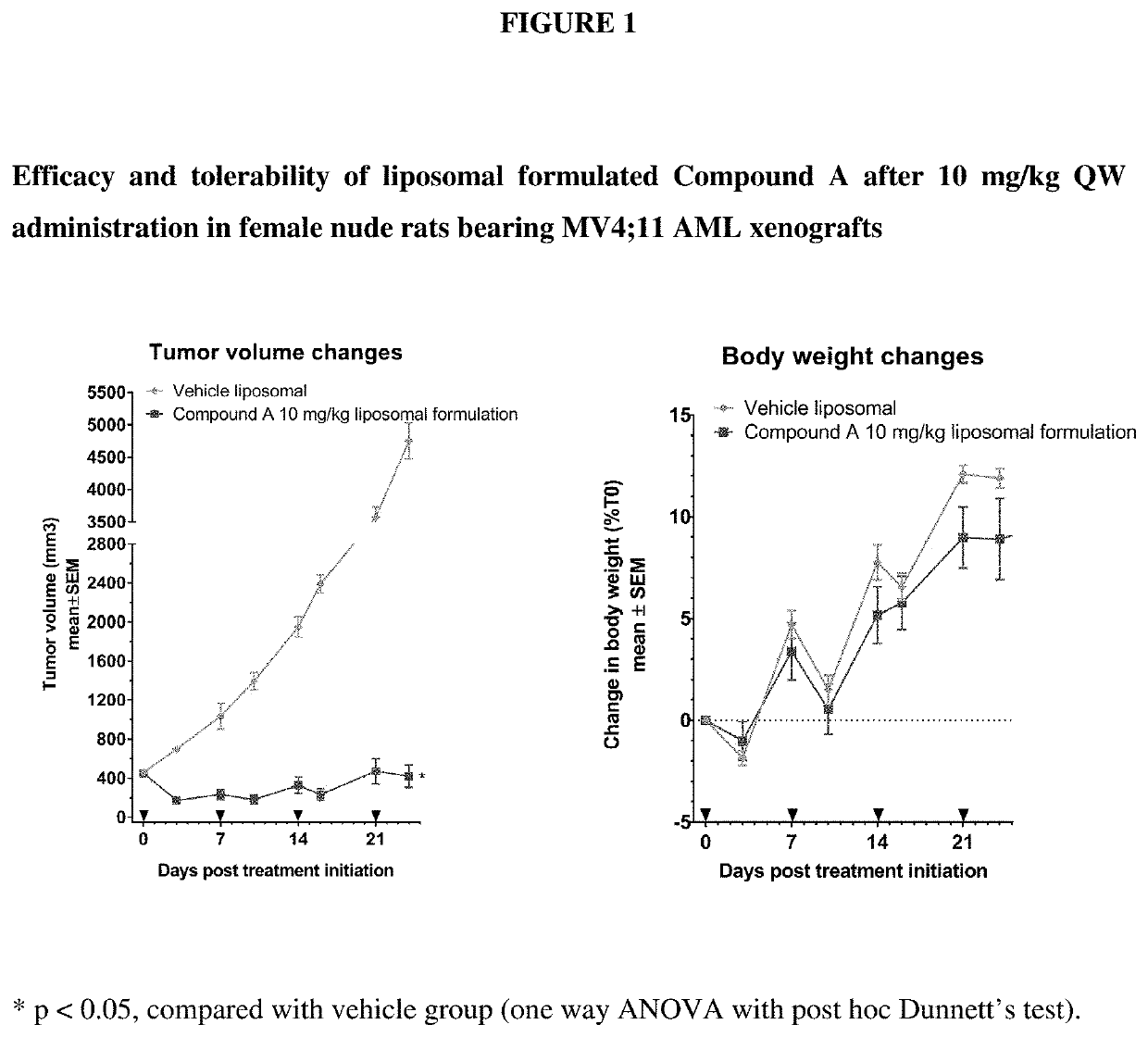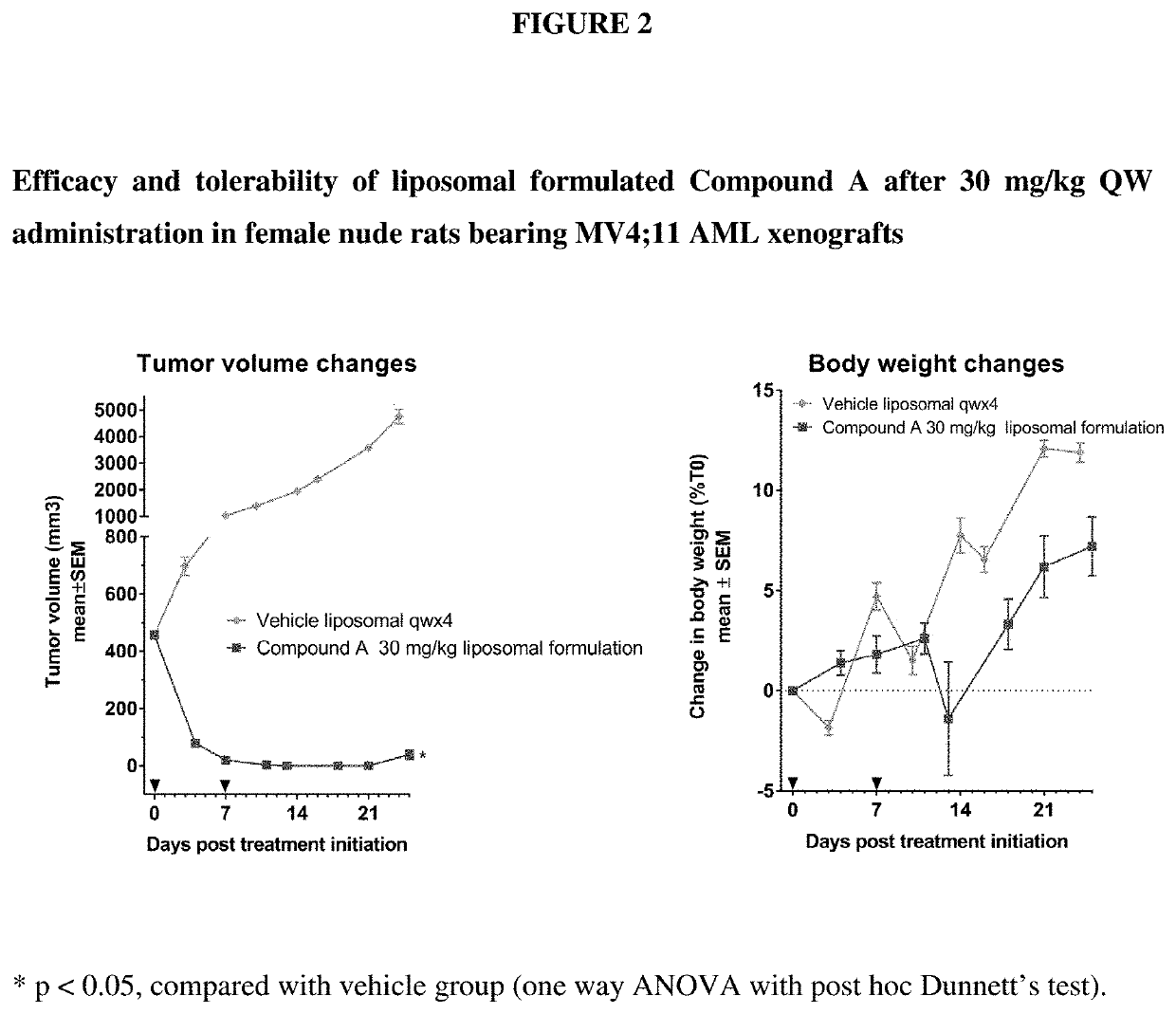Liposomal formulation for use in the treatment of cancer
a technology of liposomal formulation and cancer, applied in the field of liposomal composition, can solve the problems of ineffective solubilization, inability to predict the solubilization of a certain poorly soluble compound by phospholipids, and often associated adverse effects of surfactants, so as to avoid precipitation of components, facilitate or prevent manipulation, and improve the effect of physical stability
- Summary
- Abstract
- Description
- Claims
- Application Information
AI Technical Summary
Benefits of technology
Problems solved by technology
Method used
Image
Examples
embodiments
[0059]Described below are a number of embodiments of the invention.
[0060]E1. An organic concentrate composition comprising Compound A which is 2-{[5-{3-chloro-2-methyl-4-[2-(4-methylpiperazin-1-yl)ethoxy]phenyl}-6-(4-fluorophenyl)thieno [2,3-d]pyrimidin-4-yl]oxy}-3-(2-{[2-(2-methoxyphenyl)pyrimidin-4-yl]methoxy}phenyl) propanoic acid, or a pharmaceutically acceptable salt thereof, and a negatively charged or polar phospholipid stabiliser.
[0061]E2. An organic concentrate composition according to embodiment E1, comprising Compound A which is (2R)-2-{[(5Sa)-5-{3-chloro-2-methyl-4-[2-(4-methylpiperazin-1-yl)ethoxy]phenyl}-6-(4-fluorophenyl)thieno[2,3-d]pyrimidin-4-yl]oxy}-3-(2-{[2-(2-methoxyphenyl)pyrimidin-4-yl]methoxy}phenyl)propanoic acid, or a pharmaceutically acceptable salt thereof, and a negatively charged or polar phospholipid stabiliser.
[0062]E3. An organic concentrate composition according to embodiments E1 or E2, wherein Compound A is the free molecule.
[0063]E4. An organic co...
example 1
oncentrate Comprising Compound A and Sodium Chloride
[0243]
ExcipientCompositionComposition per mL [mg]functionCompound A61.75DMPG-Na (1,2-Dimyristoyl-3.83stabilisersn-glycero-3-phospho-rac-glycerol, sodium salt)Ethanol, anhydrous94.39solventSodium chloride4.00stabiliserWater for injection9.58solventPropylene glycol851.41solvent
[0244]Preparation of Bulk Solvent
[0245]Water for injection followed by anhydrous ethanol, then DMPG-Na are charged to a vessel and stirred to wet the DMPG-Na powder. Approximately a quarter of the propylene glycol is then added, and the mixture stirred and warmed. Stirring is continued and the temperature maintained for 90 minutes or until complete dissolution of the DMPG-Na.
[0246]After complete dissolution, the mixture is then cooled to room temperature, the remainder of the propylene glycol is added and the mixture stirred until it appears homogeneous. Sodium chloride is then added, and the mixture warmed for 90 minutes or until complete dissolution of the so...
example 2
Vehicle for Dilution
[0249]
ExcipientComposition per mL [mg]Excipient functionSucrose90tonicity adjustingagentePL, Lipoid E 80 S100solubilizer(Egg phospholipids)L-Histidine1.5bufferHydrochloric acidIf required to pH 6.5pH adjusting agentSodium hydroxideIf required to pH 6.5pH adjusting agentWater for injectionQs to 1 mLsolvent
[0250]Preparation of the Liposomal Vehicle for Dilution
[0251]As the Lecithin (ePL) is prone to oxidation, the oxygen is removed wherever technically possible and the materials are preferably to be protected by a nitrogen overlay.
[0252]Water for injection, followed by L-Histidine, are charged to a vessel and stirred until L-Histidine is completely dissolved. Sucrose is charged and the mixture stirred until the sucrose is completely dissolved. The pH is checked and adjusted to 6.5±0.2 by addition of 1N hydrochloric acid or 1N sodium hydroxide solution, then solution is stirred until homogeneous. Lipoid E 80 S is then added to the vessel. The mixture is stirred unti...
PUM
| Property | Measurement | Unit |
|---|---|---|
| size | aaaaa | aaaaa |
| size | aaaaa | aaaaa |
| size | aaaaa | aaaaa |
Abstract
Description
Claims
Application Information
 Login to View More
Login to View More - R&D
- Intellectual Property
- Life Sciences
- Materials
- Tech Scout
- Unparalleled Data Quality
- Higher Quality Content
- 60% Fewer Hallucinations
Browse by: Latest US Patents, China's latest patents, Technical Efficacy Thesaurus, Application Domain, Technology Topic, Popular Technical Reports.
© 2025 PatSnap. All rights reserved.Legal|Privacy policy|Modern Slavery Act Transparency Statement|Sitemap|About US| Contact US: help@patsnap.com



